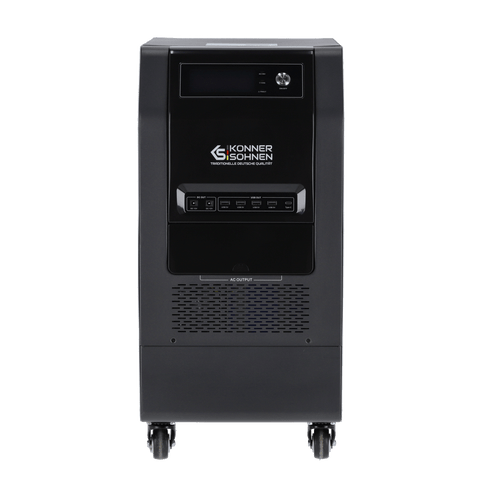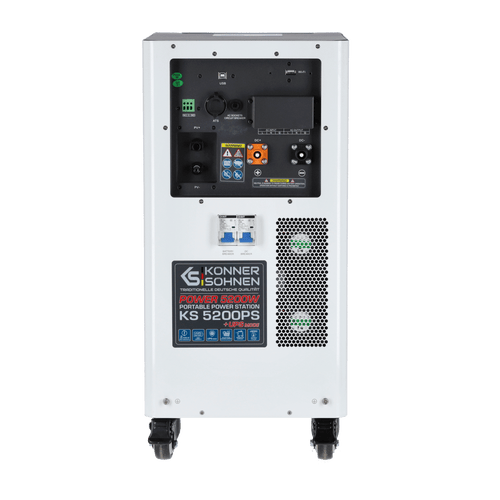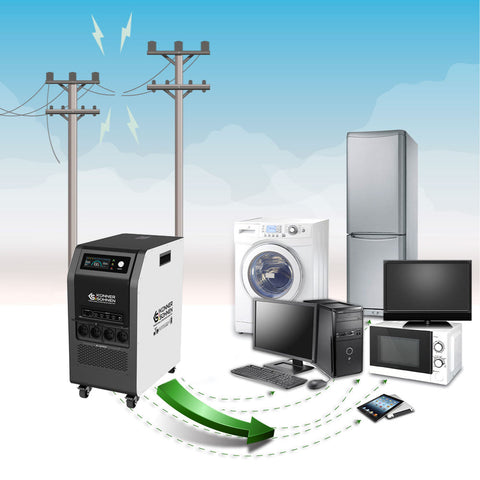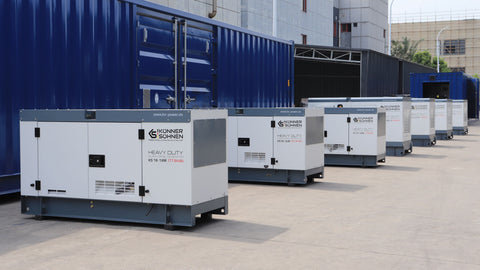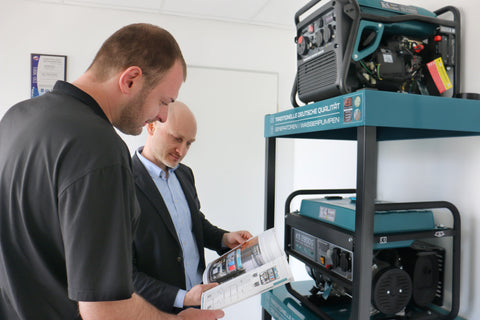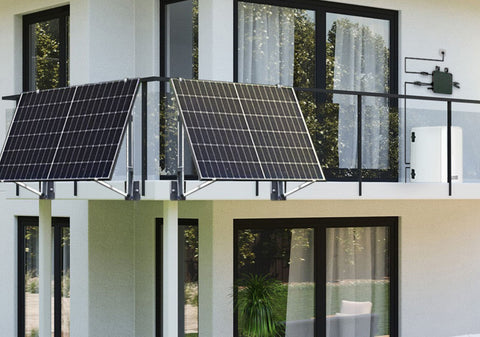Няма артикули в количката
Енергийна станция с електроцентрала KS 5200PS

Нямате достъп до обществената електрическа мрежа или сте обмисляли да станете независими от нея?
Това е възможно със слънчевата електроцентрала KS 5200PS!
Слънчевата електроцентрала KS 5200PS може да работи само с 4-6 слънчеви модула (в зависимост от изходното напрежение) и да доставя до 5200W мощност на вашите устройства. Изходното напрежение на слънчевия масив под товар не трябва да пада под 150V. Максималното напрежение на слънчевия масив е 450V на празен ход и 430V под товар. Вграденият MPPT контролер за зареждане може да преобразува до 5kW. Слънчевата енергия се съхранява в LiFePo4 батерията на слънчевата електроцентрала и се използва за захранване на вашите 230V устройства.
KS 5200PS е проектиран за стационарна употреба като TN система. Изходният неутрален проводник е свързан към PE в режим извън мрежата, за да се гарантира, че захранването на къщата е в TN система със заземен неутрален проводник и че защитата (RCD и CB) в разпределителната система функционира правилно.
Работата без заземяване е забранена.
Препоръчителна електрическа схема без връзка с мрежата:

В периоди на ниска слънчева светлина или ако слънчевата електроцентрала трябва да бъде изключена по някаква причина, е необходим допълнителен източник на захранване като резервен генератор и превключвател за прехвърляне.
KS 8100iEG:

KS 5500iEG S:

Само инверторни генератори, които доставят "чиста" синусоида 230V 50Hz и са подходящи за чувствителни потребители на електроенергия, могат да се използват като аварийни генератори.
Повечето аварийни генератори са изградени като IT системи с изолирани активни проводници. Неутралният проводник на генератора трябва да бъде заземен зад входа на захранването (вижте електрическата схема).
Вътрешните релета на KS 5200PS свързват външния източник на променлив ток на двата проводника (L и N), докато се използва като източник на захранване. Вътрешните релета изключват външния източник на променлив ток на двата проводника (L и N), докато електроцентралата преминава в режим извън мрежата.
Сервизният превключвател прехвърля потребителите на електроенергия директно към генератора, ако KS 5200PS трябва да бъде изключен за сервизни цели.
Аварийният генератор трябва да има достатъчно мощност, за да захранва едновременно потребителите на електроенергия, свързани към изхода на KS 5200PS, и да зарежда батерията на електроцентралата. Токът на зареждане на батерията на KS 5200PS от външния източник на променлив ток е фабрично настроен на 30A, което съответства на мощност на зареждане от приблизително 1700W, но може да бъде регулиран при необходимост:

Препоръчителна електрическа схема с инверторни генератори, които имат допълнителни контакти за външно управление на стартиране/спиране:

Електрическата схема се отнася за инверторни генератори, които се стартират чрез затваряне на управляващите контакти и се спират чрез тяхното отваряне. Управляващият кабел е свързан към безпотенциалните C и NO контакти на електроцентралата.
Батериите в генератори с контакти за външно управление обикновено изискват поддържащо напрежение, а контактът, показан в електрическата схема, се използва за свързване на външно зарядно устройство, което обикновено е включено с такъв генератор. Без поддържащо напрежение батерията ще се разрежда бавно и може дори да се повреди. Това е особено важно за инверторни генератори, които имат по-малки батерии, които трябва да захранват електрониката на генератора в режим на готовност.
При използване на генератори, които не изискват поддържащо напрежение, все пак препоръчваме да се зарежда батерията на всеки 1-3 месеца, ако генераторът се използва рядко.
Също така се препоръчва, в зависимост от дизайна на генератора, да се пуска генераторът за тестово изпитание на всеки 1-3 месеца, за да се промие горивната система. Срокът на годност на горивото трябва да се спазва стриктно.
При използване на генератори с ATS, които следят захранването 230V и го стартират при отпадане, можете да използвате контролните контакти NC и C, които се затварят само когато се достигне "Battery Stop Charging Voltage" и се отварят само когато напрежението на батерията падне до нивото "Battery Stop Discharging Voltage".
Препоръчителна схема на свързване с инверторния генератор KS 6000iES ATS Version 2:

ATS модулът на генератора следи напрежението 230V на MAINS INPUT в автоматичен режим, стартира генератора веднага щом това напрежение отпадне и го спира в рамките на приблизително 1 минута, веднага щом 230V се възстанови на MAINS INPUT.
KS 6000iES ATS Version 2 е проектиран само да следи напрежението 230V на MAINS INPUT и да не го пропуска, така че токът от изхода на електроцентралата да не преминава в кръг към AC входа.
Вътрешна схема на инверторния генератор KS 6000iES ATS версия 2:

Контактът CEE 230V 32A е свързан към изхода на инверторния модул и е активен само когато генераторът работи.
Страничният многофункционален въртящ се превключвател (кран за гориво, запалване, контрол на захранването) се използва за ръчно включване (позиция RUN) или изключване (позиция OFF) на генератора. Червеният бутон на многофункционалния превключвател стартира генератора в ръчен режим.
Превключвателят ATS включва автоматичния режим (ATS SWITCH ON) или го изключва (ATS SWITCH OFF).
Напрежението 230 V от изхода на KS 5200PS се насочва към MAINS INPUT на генератора чрез RCBO (устройство за претоварване и остатъчен ток) и контакти NC и C. Те се затварят, когато напрежението на батерията достигне стойността "Battery stop charging voltage" и се отварят, когато напрежението на батерията падне до "Battery stop discharging voltage". Така генераторът започва да зарежда батерията веднага след като KS 5200PS се включи и се изключва една минута по-късно, когато напрежението на батерията достигне "Battery stop charging voltage".
Кабелът към контролните контакти и към Schuko контакта е защитен от претоварване и контактна защита (RCBO). Фазовият проводник от AC изхода на KS 5200PS отива към Schuko контакта и оттам към MAINS INPUT на генератора. Неутралният проводник отива към контролния контакт C и от контролния контакт NC се връща към Schuko контакта и оттам към MAINS INPUT на генератора.
Последната версия на соларната електроцентрала KS 5200PS има DC връзки, където можете да свържете DC генератора KS 48V-DC (версия 50-55V) като допълнителен източник на енергия:

KS 48V-DC работи като зарядно устройство или заряден модул с IU характеристика:

DC генераторът KS 48V-DC предлага значителни предимства, тъй като може да следи напрежението на батерията на KS 5200PS в AUTO режим, стартира веднага щом напрежението на батерията падне под 50V и е способен да зарежда батерията с до 60A, което съответства на соларен масив от приблизително 3.3 kWp. KS 48V-DC спира в рамките на приблизително 30 секунди след като напрежението на неговия DC изход достигне 54.5-55V и токът падне под 20A.
Допълнителни батерии със същите параметри като вътрешно инсталираните LiFePo4 с номинално напрежение 51.2V от Könner & Söhnen също могат да бъдат свързани към DC входа. Паралелното свързване на външната батерия с вътрешната батерия е възможно само ако нивото на зареждане на двете батерии не се различава с повече от 20%. Ако нивото на зареждане се различава с повече от 20%, трябва да се използва само една батерия (просто включете съответния DC предпазител). Ако и двете батерии трябва да бъдат заредени, първо трябва да се активира батерията с по-ниско ниво на зареждане. Ако трябва да се захранва товар, трябва да се активира батерията с по-високо ниво на зареждане. Това е необходимо, за да се избегнат прекомерни токове между двете батерии. Прекомерният ток може да задейства защитата от претоварване на BMS на батерията. Вградените DC прекъсвачи са по-малко чувствителни от електронната защита на BMS.
Не трябва да се свързват DC консуматори на енергия или външни захранвания към DC входа! Не поемаме отговорност за дефекти или последващи щети, произтичащи от свързването на батерии, контролери за зареждане или други устройства от трети производители.
За да свържете допълнителни слънчеви полета към слънчевата електроцентрала (например, ако искате да инсталирате чифт слънчеви панели на друга страна на покрива и да ги свържете към KS 5200PS), трябва да използвате външен контролер за зареждане, който може да бъде свързан директно към DC връзките за външни DC източници на захранване. Тези връзки доставят захранване към 48V захранващата шина (KS 5200PS) с допустим диапазон на напрежение от 48-56.8V. DC връзките на KS 5200PS са защитени с DC прекъсвачи.
Настройка на слънчевата електроцентрала KS 5200PS
Достъпът до настройките на слънчевата станция KS 5200PS е възможен чрез софтуера SolarPowerMonitor чрез външен компютър.
Изтеглете софтуера SolarPowerMonitor от връзката, предоставена от производителя. След разопаковане ще намерите 4 файла:

Първо трябва да инсталирате първите 2 файла, за да се инсталират необходимите драйвери за комуникация чрез USB. Програмата SolarPowerMonitor се инсталира във втората стъпка.
Електроцентралата е свързана към USB порта на компютъра с предоставения кабел. Краят на кабела с USB Type A се включва в компютъра, а краят с USB Type B се включва в USB порта на електроцентралата.
След стартиране, SolarPowerMonitor търси свързани електроцентрали.
Веднага след като бъде намерена свързаната електроцентрала, се появява прозорец с текущото състояние на електроцентралата. За да получите пълен достъп до настройките, трябва да влезете с паролата "admin":

Достъпът до настройките на инвертора вече е наличен:

Настройки по подразбиране за KS 5200PS:

По подразбиране режимът на работа е SUB. В този режим вътрешната батерия на електроцентралата се зарежда само от външния AC източник на захранване до "Battery Stop Charging Voltage", което е приблизително 60-70%. В този режим батерията може да се зарежда до 100% само чрез PV входа.
Настройки за KS 5200PS в енергийна островна система:
Аварийният генератор се използва като външен източник на захранване в енергийна островна система.
Тъй като KS 5200PS е предназначен да се зарежда от външния AC генератор, препоръчваме да превключите режима на работа на UTI, в който батерията може да се зарежда до 100% от външния AC източник на захранване.

Тъй като електроцентралата може да се зарежда до 100% в режим UTI, може да се появи предупреждение със звуков сигнал, докато BMS се затваря. Това обаче рядко се случва и ако зададете висок ток на зареждане "Grid max charger current set". За да деактивирате звуковия сигнал, моля, активирайте опцията "BuzzForbide(only use by PV1800)" (отметнете полето) и потвърдете. За да активирате отново звуковия сигнал, трябва да активирате опцията "GridBuzzEnable (only use by PV1800)" (отметнете полето) и потвърдете.
При използване на генератора в автоматичен режим, препоръчваме да зададете параметъра "Battery stop charging voltage" на 54V, за да може генераторът да зарежда батерията до 80%. За да се гарантира, че батерията се зарежда в рамките на 3-4 часа (което съответства на препоръчителното време на работа на повечето аварийни генератори) и 5 kW инверторен генератор, например, все още има достатъчно мощност за домашни електрически консуматори, препоръчваме да зададете тока на зареждане на батерията от външния източник на захранване на 30A. Препоръчваме да зададете стойността на "Battery stop discharging voltage" на 50V, за да не стартира генераторът твърде рано, а само когато SOC на батерията достигне приблизително 15-20%.

При използване на DC генератора, всички тези настройки са ирелевантни, тъй като KS 48V-DC доставя енергия директно към 48V захранващата шина на електроцентралата, която захранва инверторния модул и също така зарежда вътрешни и външни батерии, които също са свързани към 48V захранващата шина чрез прекъсвачи на задната част на електроцентралата.
Ако KS 48V-DC не се използва в режим AUTO, а в режим EXTERNAL CONTROL, трябва да се зададат желаните стойности за "Battery stop charging voltage" и "Battery stop discharging voltage", и контактите на EXTERNAL CONTROL трябва да бъдат свързани към съответните C и NO контакти на електроцентралата.
Ако имате допълнителни въпроси или притеснения, моля, свържете се с техническата поддръжка на Könner&Söhnen по имейл на support@dimaxgroup.de
Отказ от отговорност:
Тези инструкции могат да се възприемат само като препоръка, са описателни и трябва да бъдат адаптирани към конкретните обстоятелства и условия на място по време на инсталацията. Самата инсталация трябва да се извършва в съответствие с всички стандарти и разпоредби. Не поемаме отговорност за неправилни инсталации и техните последствия.

